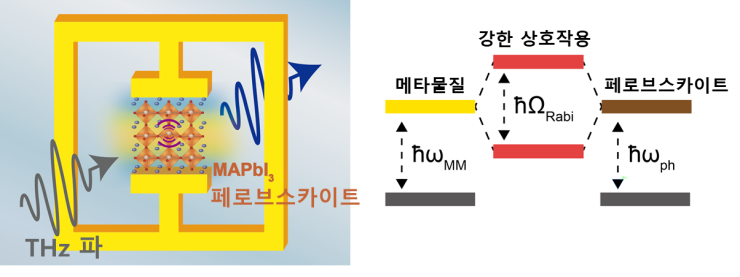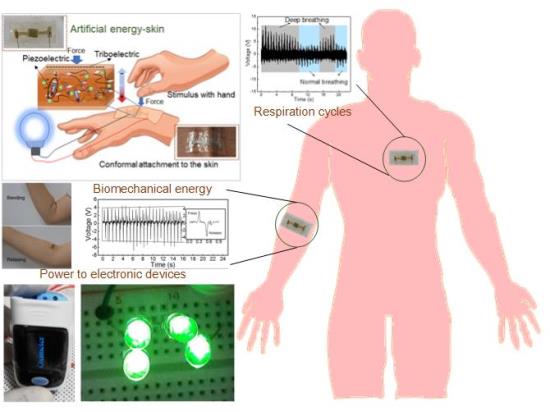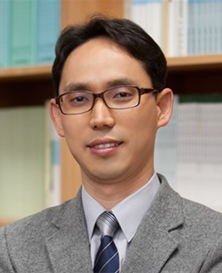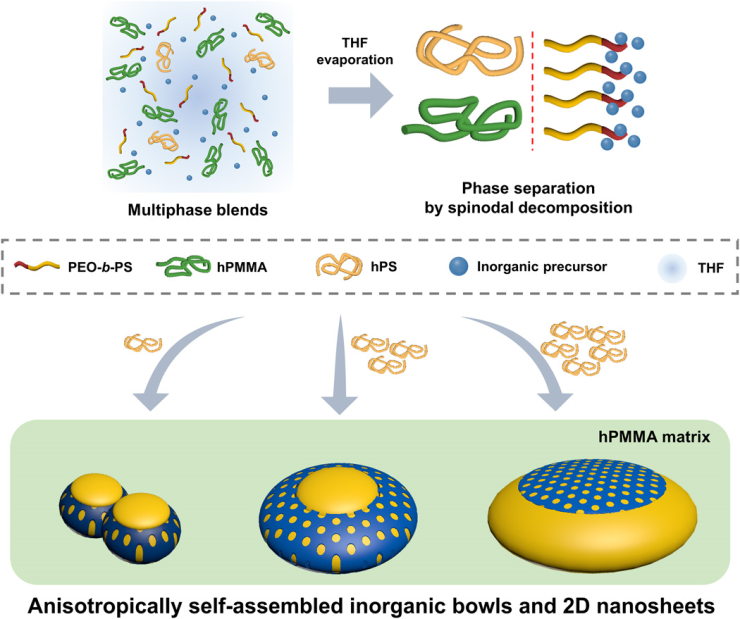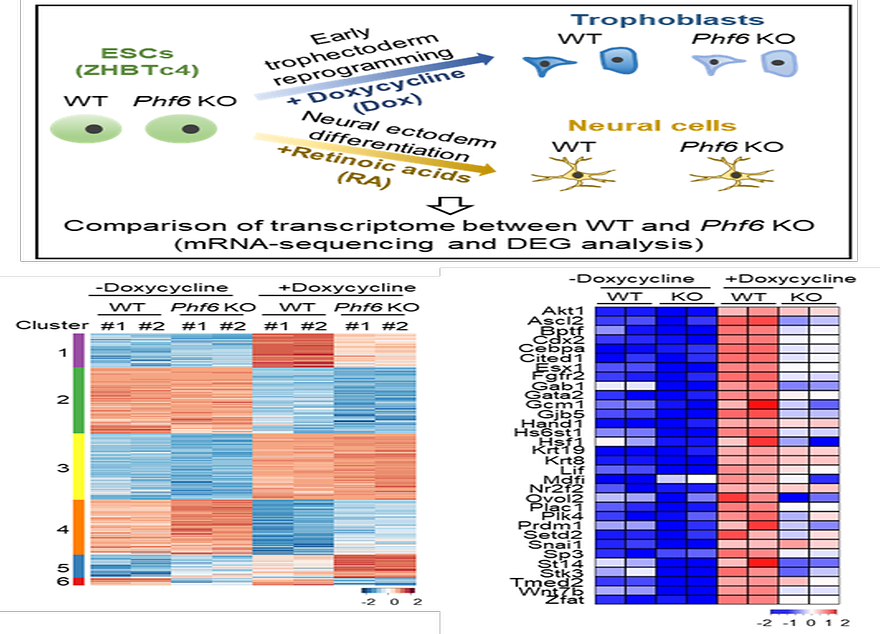-
A team of researchers led by Prof. Ahn Yeong-hwan (Departments of Physics and Energy Systems Research, pictured) has succeeded in creating a new quantum energy level using a material that is expected to become central to next-generation solar cells.The team’s work was published in the September issue of Nano Letters (IF = 12.344) with the title, “Phonon-Polaritons in Lead Halide Perovskite Film Hybridized with THz Metamaterials.” The team included other Ajou faculty members, including professors Ha Na-young, Park Ji-yong and Lee Soon-il, all with the Department of Physics, as well as Prof. Kim Dai-sik of the Ulsan National Institute of Science and Technology (UNIST). Kim Hwan-sik, doctoral candidate in physics at Ajou, also participated as first author.The team created a hybrid of the perovskite film and the metamaterial used to create invisibility cloaks and tested how light in the terahertz range, between infrared rays and microwaves, behaved on it. The perovskite used for this particular experiment was a lead halide type, widely expected to become the central material of much more efficient solar cells in the future.The perovskite hybrid, in its oscillating mode, reacted strongly with the electronic waves concentrated in the meta-structure, giving rise to a new phonon-polariton energy level. An energy level is the value of energy at its atomic and molecular levels. It refers to the level of energy that electrons absorb or release.The team also demonstrated that the new energy level varies depending on numerous conditions or variables. The most important of these variables is crystallinity of the perovskite film. The team discovered, for the first time in the world, that the dynamics of the phonon-polariton energy level vary by the nanocrystal growth dimensionality (one-, two-, or three-dimensional). The team also succeeded in introducing a new model for explaining the interaction between nanocrystals that grow over time and light. Prof. Ahn explained: “Our latest discovery can be applied to assessment of the crystal structure of next-generation solar cell films as well as optimization of their efficiency. Through follow-up research on the perovskite-metamaterial hybrid, we were also able to find lighting sources for future quantum optics.”The project was made possible in part thanks to the Mid-career Researcher Program, co-managed by the Ministry of Science and ICT and the National Research Foundation of Korea, and Korea Energy Technology Evaluation and Planning (KETEP)’s Energy Workforce Development Program.THz 파THz raysMAPbl3 페로브스카이트MAPbl3 perovskite메타물질Metamaterial강한 상호작용Strong reaction페로브스카이트PerovskiteMechanism of the new energy level based on the perovskite film-metamaterial hybrid
-
15
- 작성자OI***
- 작성일2020-12-18
- 5373
- 동영상동영상
-
Using an engineered silk protein, a team of researchers led by Prof. Kim Sung-hwan (Departments of Physics and Energy Systems Research) has succeeded in developing artificial tissues capable of generating energy. The invention is expected to accelerate the development of next-generation healthcare devices that can be incorporated into existing human tissues.Prof. Kim’s human-friendly artificial skin, made of an engineered silk protein and capable of harvesting electric energy from human motions, was published in the August 23 online issue of Nano Energy, a renowned international publication, and entitled, “Self-powered artificial skin made of engineered silk protein hydrogel.”There is a fast-growing body of research worldwide on materials for next-generation electronic healthcare devices for human-machine interfacing. Such devices are to detect and analyze vital signs automatically, and developing them requires electronic materials that can provide as much flexibility and elasticity as actual human skin. Countless researchers have thus dedicated themselves to developing materials and devices that combine flexible substrates with electrodes and electronics to read and analyze various vital signs from the human body. These materials are today known as electronic skin.It is crucial for electronic skin devices to run on their own, without relying on outside power sources. One way to achieve this is to develop a piezoelectric energy-harvesting mechanism capable of transforming differences in pressure resulting from the wearer’s motions into electric energy. Existing piezoelectric materials are mostly inorganic oxides whose crystalline structures are capable of high levels of piezoelectricity. The majority of these materials, however, are neither skin-friendly nor flexible enough to serve as a second skin for humans. Materials with sufficient flexibility, on the other hand, lack the needed piezoelectric capability. When pressure hits and deforms the existing molecular structure of a given substance, electric charges arise in parts of that substance, which can be harvested to generate energy. The greater the quantity of charges generated due to structural deformation, the more piezoelectric the substance is. Therefore, flexible materials, by definition, fare worse than hard ones in piezoelectric energy generation.Prof. Kim’s team sought to resolve this problem with proteins—particularly silk proteins available from natural sources—as they are a core component of the skin. Silkworm-derived proteins are a skin-friendly and high-molecular biomaterial with superior physical and chemical properties. In an effort to transform the silk protein at the molecular level, the team applied glycerol and created a transparent and flexible hydrogel film. The resulting product is similar to human skin, taking the research community a step closer to finding an ideal artificial electronic counterpart.Prof. Kim’s team, moreover, combined the transparent silk protein with a zinc oxide (ZnO) nanorod to maximize the material’s piezoelectric performance. This ensures that a wearable device made with the new material would stay comfortably on the wearer’s skin and reliably harvest electric energy from the wearer’s motions, including touches and flexing of the joints. The team indeed demonstrated that its piezoelectric material can harvest sufficient amounts of energy from normal human motions to charge and operate small electronic devices, such as light-emitting diodes (LEDs) and blood oximeters. Accordingly, the team’s invention can be applied to a variety of sensors, including those for electronics and human motion detectors.Prof. Kim explained: “Although there has been significant progress in research on harvesting energy from the human body, the problems related to human-machine interfacing has comparatively been neglected. My team and I have found a clue in proteins, which compose the natural skin, to develop interfaces capable of bridging the material difference between the human body and electronic devices.”He added: “Our project is significant in that our invention can help increase the application of biomaterials to a variety of electronic devices. We hope to see our product applied to a wide range of healthcare products and soft robotics in the future.”[Description] A conceptual diagram of Prof. Kim’s self-powered artificial skin. It can be attached to human skin to capture and harvest energy from the wearer’s motions. The amount of energy so harvested is enough to operate small devices.
-
13
- 작성자OI***
- 작성일2020-12-18
- 4951
- 동영상동영상
-
A team of Ajou scientists has developed a near infrared ray (NIR) photodetector capable of detecting deterioration and damage in human muscle structures. The new device is expected to have many applications, including medical imaging equipment that requires highly sensitive and efficient sensors.The team, led by (Dept. of Materials Science and Engineering / Graduate Dept. of Energy Systems, pictured), has developed a new image sensing device using alternating current photovoltaic effects, which offer high detectivity and rapid rise/decay time. The development was introduced in an article entitled, “Broadband alternating current photovoltaic effect: An application for high-performance sensing and imaging body aches” in the August 29 online issue of Nano Energy (IF = 16.602). The team includes Prof. Park Ji-yong yong (Dept. of Physics / Graduate Dept. of Energy Systems Research), Prof. Kim Sang-wan (Dept. of Electrical and Computer Engineering), and Dr. Mohit Kumar (first author).Photodetectors, which convert light into electric signals, have so far been associated with solar energy cells. But these devices have much broader application, as they are essential not only in new and renewable energy, but also smartphones, the Internet of Things (IoT), and optical communications. Lately, there has also been growing interest in developing medical applications as well, as photodetectors can help make diagnosis and ongoing monitoring of patients far easier. Industries and academia alike have been particularly interested in photodetector technology that can facilitate the imaging of damage to muscles inside the human body. Photodetectors are already being used in assessing patients with advanced-degree burns.Photodetector researchers, in turn, have been paying attention to NIRs, as they are expected to minimize further damage to the body by light and enable the detector to sense at greater depths of internal tissues and organs. As a result, there has been great demand for high-performance photodetectors capable of detecting even the slightest changes in NIR signals. Such photodetectors would also have to be highly energy-efficient to be installed on portable medical diagnostic devices.Compound semiconductors have been the typical choice for NIR-based photodetectors so far. These compound semiconductors, including gallium-arsenic, however, are quite expensive, have low levels of detectivity in the NIR range, and have not performed well thus far. Most critically, they fail to have the high level of detectivity necessary for medical devices to identify and image damage inside the human body.Prof. Seo’s team has sought to overcome this by laying a quality titanium oxide (TiO2) nanofilm onto a silicone (Si) substrate and controlling the surface characteristics. The researchers have also succeeded in developing a photodetector structure that maximizes optical responsivity using silver nanorays. As a result, the team was able to create a high-performance photodetector promising a much higher switching ratio (≈1E4), detectivity (≈1E11 Jones), and response time (~ 120 μs) than available today. The resulting photodetector is superior in all areas of performance over the NIR photodetectors available today.The alternating photovoltaic current enables the photodetector to generate energy from the rapidly flickering incident rays on its own, eliminating the need to connect it to an outside power source. The photodetector, moreover, generates photovoltaic currents that are nearly 39,000 times greater than direct photovoltaic currents typical of solar cells, making it very well-suited to medical imaging.Prof. Seo’s team has also identified the operating mechanism of the photodetector using Kelvin probe force and electrostatic force microscopy. The alternating incident rays generate inhomogeneous absorption-induced imbalanced carriers inside the semiconductor. The resulting quasi-Fermi level splitting and realignment, the researchers demonstrated, ensures fast response and high detectivity by the photodetector.Prof. Seo: “We successfully imaged internal changes in the muscular tissues of the fingers by scan-imaging them with our photodetector.” He explained, “With this device, we will be able to detect [the locations of] body aches and pain and image them at ultra-high speed. We expect the photodetector will be applied to scanning and diagnosing various other types of changes occurring not just in muscles, but in other parts of the body as well, particularly for pediatric patients.”The team’s research project was made possible in part thanks to the Program for the Future New Material and Original Technology Development Program and the Basic Research Support Program for Experienced Researchers, both from the Ministry of Science and ICT and the National Research Foundation of Korea. A patent application on the invention is now pending.
-
11
- 작성자OI***
- 작성일2020-12-18
- 5166
- 동영상동영상
-
A team of researchers including Ajou’s own Prof. Hwang Jon-kook (Department of Chemical Engineering) has developed a new original technology for controlling the shapes of porous nanomaterials. The team’s discovery is expected to help solve current roadblocks to innovation in various fields, including secondary cells and energy storage systems, as well as energy, catalysts, environmental engineering, and medicine.The article, listing Prof. Hwang as the principal author, was published in the August 12 online issue of Science Advances (IF = 13.116, JCR 4.93%), a sister publication of Science. Dr. Kim Seong-seop and Prof. Lee Jin-woo of the Korea Advanced Institute of Science and Technology (KAIST) were also on the team.The title of the article reads: “Polymer blend directed anisotropic self-assembly toward mesoporous inorganic bowls and nanosheets.”The team has developed a new mechanism which can easily control the shapes of molecules and nanostructures by simply combining and heating an organic polymer blend and an inorganic metal oxide precursor. Furthermore, the team demonstrated that the dish-shaped niobium oxide created by applying their method offers the highest-possible levels of performance and safety when used as an anode for a potassium ion battery, which garners attention as a potential material for next-generation secondary batteries.Researchers worldwide have so far sought to control the shapes of porous materials through complex and often expensive methods. These methods, however, failed to ensure precise and efficient control of porous nanostructures and particles. Accordingly, there has been growing demand for a new technique that is simpler, less expensive, and more capable of controlling all relevant factors, including size, structure and shape of pores.Prof. Hwang’s team found a solution in the self-assembly effect of multicomponent polymer blends. Multicomponent polymer blends can assemble themselves into complex and sophisticated nanostructures when certain conditions are met. Although this mechanism has long been known in polymer physics, few actual applications have been made out of it.Prof. Hwang’s team established a design guideline that brings together the self-assembly mechanism of multicomponent polymer blends with inorganic material chemistry, and the result—the anisotropically self-assembled particle (ASAP)—was thus born, promising simple and easy ways to control nanostructure, chemical composition and shape of porous materials.Prof. Hwang explains: “Our work is significant in that it demonstrates, for the first time, that self-assembling polymer blends can be used to solve the problem with synthesizing porous inorganic materials.” He adds, “This means that we can now pioneer new fields of interdisciplinary research that connect polymer physics and inorganic material chemistry.”As a nanoenergy and material specialist, Prof. Hwang has long been researching ways to control the structures and shapes of porous nanomaterials. His future research plans include finding simple methods for synthesizing inorganic porous materials and producing customized designs for electrodes of next-generation secondary batteries.*Pictured: A diagram of ASAP, a porous inorganic material using the self-assembly of a multicomponent polymer blend.
-
9
- 작성자OI***
- 작성일2020-12-18
- 4629
- 동영상동영상
-
A team of researchers with the participation of Ajou Professor Park Dae-chan (Department of Biological Sciences) has found a new clue to preventing disruptions to the placenta, vital to fetal growth and nutrition. The team’s discovery of a new factor critical to placental development is expected to catalyze development of new solutions to ensure early fetal health.The team’s article, published in the July 31 online issue of Nucleic Acids Research (Impact factor: 11.501, IF% = 4.882), was entitled, “The chromatin-binding protein PHF6 functions as an E3 ubiquitin ligase of H2BK120 via H2BK12Ac recognition for activation of tophectoderman genes.” The team also included Prof. Baek Sung-hee of Seoul National University and Prof. Lee Ji-min of Kangwon National University.The team discovered the importance of an epigenetic factor known as PHF6 in the trophectoderm of the blastocyst in placental formation. Blastocysts are sphere-shaped bundles of cells that contain embryonic stem cells, surrounded by trophectoderms. Trophectoderms form the embryo and the placenta, and how epigenetic factors regulate trophectodermal differentiation has not been understood until now.Based on an mRNA-sequencing genomic analysis, an emerging method for analyzing nucleic sequences, Prof. Park’s team discovered that embryonic stem cells from which PHF6 was removed led to disruptions in the formation of blastocysts and the placenta.PHF6 is an epigenetic factor protein that recognizes histone modifications. The team found that PHF6, by recognizing the chemical modifications (acetyl group) to histone proteins surrounding DNA, additionally binds ubiquitin to the histone. In other words, the researchers confirmed that histone modifications by PHF6 is what regulates the expression of trophectodermal genes in blastocysts.The team explained: “We have demonstrated that it is possible to modify the placental developmental process epigenetically using histone proteins that are dissolved and resynthesized in just days, instead of modifying the DNA nucleic sequences transmitted down the generations.”The research was made possible with the help of the Ministry of Science and ICT (MSIT) and the National Research Foundation of Korea (NRF)’s Leading Research Support, Individual Basic Science and Engineering Research, and New Researcher Support Programs.
-
7
- 작성자OI***
- 작성일2020-12-18
- 4627
- 동영상동영상

